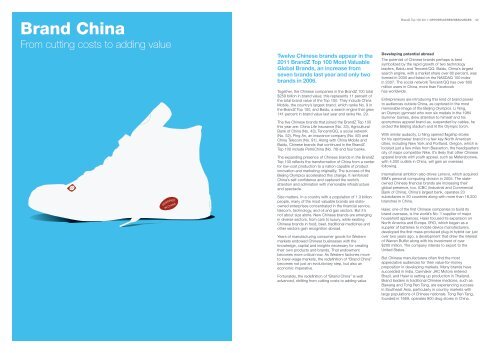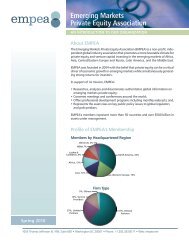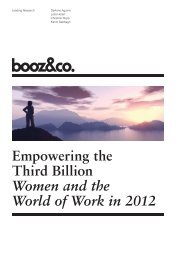Top 100 - Wamda.com
Top 100 - Wamda.com
Top 100 - Wamda.com
- No tags were found...
You also want an ePaper? Increase the reach of your titles
YUMPU automatically turns print PDFs into web optimized ePapers that Google loves.
Brand ChinaFrom cutting costs to adding valueBrandZ <strong>Top</strong> <strong>100</strong> 2011: OPPORTUNITIES/RESOURCES 92Twelve Chinese brands appear in the2011 BrandZ <strong>Top</strong> <strong>100</strong> Most ValuableGlobal Brands, an increase fromseven brands last year and only twobrands in 2006.Together, the Chinese <strong>com</strong>panies in the BrandZ <strong>100</strong> total$259 billion in brand value; this represents 11 percent ofthe total brand value of the <strong>Top</strong> <strong>100</strong>. They include ChinaMobile, the country’s largest brand, which ranks No. 9 inthe BrandZ <strong>Top</strong> <strong>100</strong>, and Baidu, a search engine that grew141 percent in brand value last year and ranks No. 29.The five Chinese brands that joined the BrandZ <strong>Top</strong> <strong>100</strong>this year are: China Life Insurance (No. 33), AgriculturalBank of China (No. 43), Tencent/QQ, a social network(No. 52), Ping An, an insurance <strong>com</strong>pany (No. 83) andChina Tele<strong>com</strong> (No. 91). Along with China Mobile andBaidu, Chinese brands that continued in the BrandZ<strong>Top</strong> <strong>100</strong> include PetroChina (No. 78) and four banks.The expanding presence of Chinese brands in the BrandZ<strong>Top</strong> <strong>100</strong> reflects the transformation of China from a centerfor low-cost production to a nation capable of productinnovation and marketing originality. The success of theBeijing Olympics accelerated this change. It reinforcedChina’s self-confidence and captured the world’sattention and admiration with memorable infrastructureand spectacle.Size matters. In a country with a population of 1.3 billionpeople, many of the most valuable brands are stateownedenterprises concentrated in the financial service,tele<strong>com</strong>, technology, and oil and gas sectors. But it’snot about size alone. New Chinese brands are emergingin diverse sectors, from cars to luxury, while existingChinese brands in food, beer, traditional medicines andother sectors gain recognition abroad.Years of manufacturing consumer goods for Westernmarkets endowed Chinese businesses with theknowledge, capital and insights necessary for creatingtheir own products and brands. That endowmentbe<strong>com</strong>es more critical now. As Western factories moveto lower-wage markets, the redefinition of “Brand China”be<strong>com</strong>es not just an evolutionary step, but also aneconomic imperative.Fortunately, the redefinition of “Brand China” is welladvanced, shifting from cutting costs to adding value.Developing potential abroadThe potential of Chinese brands perhaps is bestsymbolized by the rapid growth of two technologyleaders, Baidu and Tencent/QQ. Baidu, China’s largestsearch engine, with a market share over 80 percent, wasformed in 2000 and listed on the NASDAQ <strong>100</strong> indexin 2007. The social network Tencent/QQ has over 600million users in China, more than Facebookhas worldwide.Entrepreneurs are introducing this kind of brand powerto audiences outside China, as captured in the mostmemorable image of the Beijing Olympics. Li Ning,an Olympic gymnast who won six medals in the 1984Summer Games, drew attention to himself and hiseponymous apparel brand as, suspended by cables, hecircled the Beijing stadium and lit the Olympic torch.With similar audacity, Li Ning opened flagship storesfor his sportswear brand in a few key North Americancities, including New York and Portland, Oregon, which islocated just a few miles from Beaverton, the headquarterscity of major <strong>com</strong>petitor Nike. It’s likely that other Chineseapparel brands with youth appeal, such as Metersbonwe,with 4,000 outlets in China, will gain an overseasfollowing.International ambition also drives Lenovo, which acquiredIBM’s personal <strong>com</strong>puting division in 2005. The stateownedChinese financial brands are increasing theirglobal presence, too. ICBC (Industrial and CommercialBank of China), China’s largest bank, operates 23subsidiaries in 20 countries along with more than 16,200branches in China.Haier, one of the first Chinese <strong>com</strong>panies to build itsbrand overseas, is the world’s No. 1 supplier of majorhousehold appliances. Haier focused its expansion onNorth America and Europe. BYD, which began as asupplier of batteries to mobile device manufacturers,developed the first mass-produced plug-in hybrid car justover two years ago, a development that drew the interestof Warren Buffet along with his investment of over$200 million. The <strong>com</strong>pany intends to export to theUnited States.But Chinese manufacturers often find the mostappreciative audiences for their value-for-moneyproposition in developing markets. Many brands havesucceeded in India. Carmaker JAC Motors enteredBrazil, and Haier is setting up production in Thailand.Brand leaders in traditional Chinese medicine, such asBawang and Tong Ren Tang, are experiencing successin Southeast Asia, particularly in country markets withlarge populations of Chinese nationals. Tong Ren Tang,founded in 1669, operates 800 drug stores in China.
















